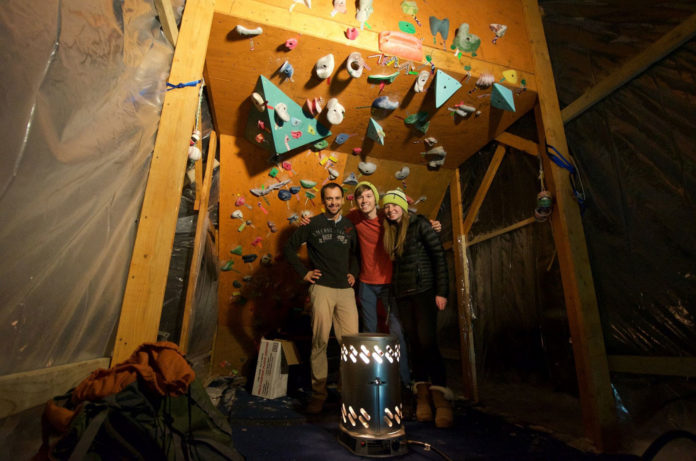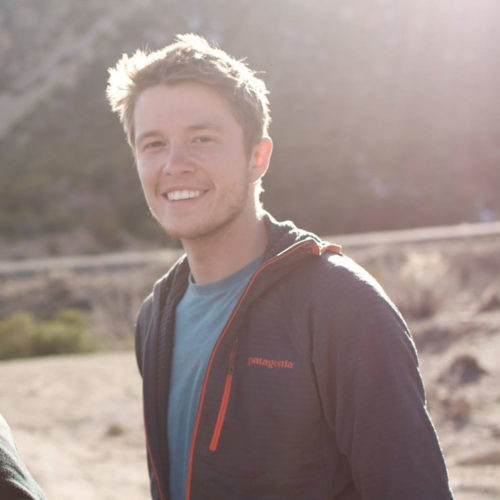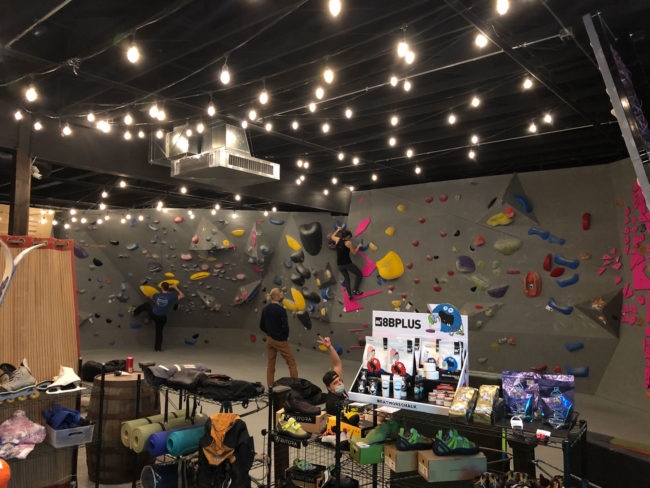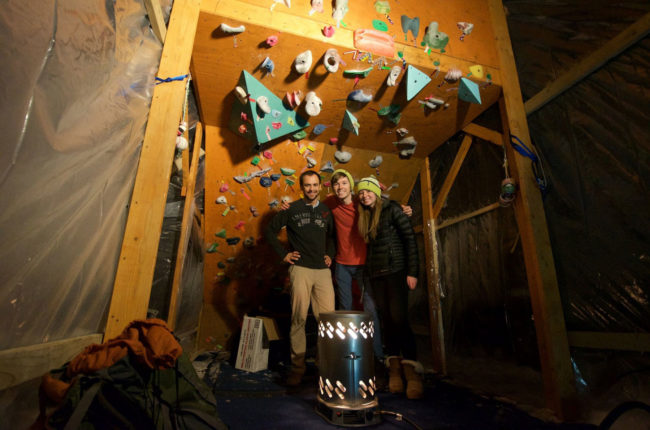
Behind the Wrench…is an ongoing series that interviews the “rock stars” of the climbing industry: the routesetters at the gyms. For this installment, we head north to talk with Christopher Deal. Deal has an interesting personal story. He initially intended to start his own gym in Fargo, North Dakota. But those plans changed when a nearby business called Nature of the North (which offers outdoor trips and workshops) wanted to start offering outdoor climbing trips—and brought Deal on board to spearhead them. Eventually that idea morphed into the construction of an indoor bouldering wall and some training walls—where Deal now works as the only full-time climbing staff member. That’s certainly not the typical path for becoming a head routesetter, but it made us even more curious to know Deal’s full story.

Name: Christopher Deal
Instagram: @ChrisDealios
Title: Director of Climbing
Home Gym: Nature of the North
Location: Moorhead, Minnesota
CBJ: I personally love the Fargo area [Fargo and Moorehead being separated by a river]…but it is not exactly thought of as a region steeped in routesetting history. So, can you tell me about your journey and how you learned to set routes?
DEAL: Being a climber in Fargo/Moorhead was hard, but getting into setting is even more difficult. I started climbing about 8.5 years ago, and started setting shortly after. At that point the only places to climb were a teeny, tiny YMCA, a NDSU [North Dakota State University] Wellness Center, MSUM [Minnesota State University Moorhead] Wellness Center, and a home wall or two. I was lucky enough to get in at the YMCA and be adopted by the two premier climbers of the area (shout-out to Gabe Olson and Paul Kummer). They started letting me set at the YMCA. The terrain there was not steep at all—I think the steepest wall was 15 degrees—so all the climbing was near-vertical. It emulated the style of the local climbing (four hours away—Red Wing), which was all crimpy with horrible feet. Very technical.
Shortly after starting at the YMCA, I started setting at the NDSU wall, which is a Nicros A.R.T.Wall that can be very challenging to set on. Like the YMCA, NDSU was all vertical. Then, in 2016, I got the chance to do the Level 1 setting course in Minneapolis. After that, I kind of took a hiatus from routesetting; I wasn’t working at any of the walls in town, and I had a boring job while back in school to get my MBA. So, I built a MoonBoard in my garage and just went all out on it. I felt like the MoonBoard helped me a lot. It let me see a lot of moves broken down very simply, and how the position of a foot or hand can change the problem entirely.
What are some things that you love about the climbing community in Fargo and Moorhead?
I think the Midwest psych is very high here. We have had a very good climbing community, despite being four hours from any outdoor climbing. We will climb in the most awful conditions and still be super psyched. Before we built the bouldering wall at Nature of the North, we had an outdoor wall wrapped in the plastic sheeting that is used in construction. We would use a propane heater to heat the space all winter long. At the top of the wall it would be around 120 degrees, while the floor was around 0 degrees. We would do this all winter. (I’m not sure what is more miserable though: climbing in there on -30-degree winter nights, or climbing there on 110-degree summer days.)
I also love the Fargo/Moorhead scene because you get to interact with so many first-time climbers. With the limited number of facilities here, it’s not too common to ‘be a climber.’ So, watching and being a part of that journey is very rewarding.

How would you describe your own routesetting style? Do you have any unique preferences or quirks in your methodology?
I definitely prefer things that resemble climbing outdoors—especially crimps and poor feet. I really love small, flat edges that require finger strength and correct body position. I am not sure if this is unique to me, but I really like setting top-down. That is the way I was taught; I like the speed of it, and I feel like I come up with better sequences that way.
You’re the only full-time climber/staffer at Nature of the North, but do you have a crew or other routesetters who help you set?
My crew is just me for the most part. We have a couple climbers who come in part-time. Since we are so small, our setting needs aren’t as intense. We like to bring in guest routesetters from the area and let them set some routes. Through that, I think I’ve learned a lot about communication and constructive criticism. If something isn’t working on a boulder, it does more good to be honest. In the end, we all want the best climbing experience for our customers. Since we are small, it allows for a lot of collaboration—so that communication really shows when we all work to make a problem the best it can be. For example, I am not the best at coordination and competition-style routesetting. Luckily, one of our team members is. Oftentimes we try and set in our anti-styles: I’ll set something with coordination and he will climb it and critique it. Hopefully I learn something and can take the criticism to the next set. Together with his help, we set something better.
Let’s talk about tools of the trade. Do you have any preferred drills and wrenches? Or any particular holds or brands that you really love to set with?
Good question. So, when I started climbing, we had zero access to replace t-nuts at the YMCA—so we used only wrenches. The A.R.T.Walls from Nicros are similar; the replacement is a Disk Doctor over the original t-nut. My favorite tool is actually the tap for the t-nuts. Now that I have access and can replace any t-nut on the wall, I love my impact driver. I use a DeWalt right now, but I’ll be replacing it soon with a Makita.
Holds—I love Teknik and Kumiki. I’ve been having a lot of fun with the Kumiki Flow Edges; they’re very challenging on our steeper walls, and the dual texture is so nice and makes dialing and forcing moves a breeze. From Teknik, I love the Meatlets and Minimeats…edges that make it hard to use my thumb, I am a big fan of. Lastly, eGrips Buttons. They advertise them as foot chips, but we have them on the 40-degree wall.

How has your routesetting style evolved over time? I mean, is there anything you wish you could go back and tell the earlier version of yourself as a routesetter?
When I first started routesetting, it was more about challenging myself and the other climbers I was with. It was always the big thing to set something that nobody else could do. I’ll admit I wasn’t too concerned with anyone else’s ‘experience;’ I was definitely setting selfishly. It was all about who could set the hardest route or problem. It wasn’t until establishing a climbing business and trying to grow that business that it became about the first-time experience.
I am much more into the first-time climber experience now, and how we make first-time climbers into second-time climbers, and members, and program-consumers.
If I could go back and tell myself one thing, it would probably be variety. Not everything needs to be crimpy. Just like climbing, you get better at setting certain styles by setting those problems. It’s awesome though, with our new wall and volumes and holds we can set a lot more comp-style boulders. Making a seasoned climber and newer climber struggle on the same problem is a super fun interaction to be a part of!
In your opinion, what’s the biggest issue in routesetting today?
I think recognizing the value of routesetters and quality routesetters. Routes and problems are the single most important part of a gym. You can have the nicest, most expensive walls…but if the climbs aren’t fun, none of that matters. Having more accessible routesetting instruction, and supporting setters fairly to ensure that they stick around is a must.
In closing, can you describe the most recent route you set—and explain what makes it awesome?
Hmm…I have two in mind. First, we have some eXpression fiberglass volumes, and for this last set, I put them on a slight overhang and made a super cool, approachable line. Hearing our newer climbers come in and get excited about finally being able to climb on those volumes, and seeing them climb it, has been very enjoyable.
The second is a super slopey climb up our steep wall—40 degrees. The holds feel amazing with the right sequence of toe hooks and drop-knees, but if you lose tension, you are off the wall super quick. It’s fun to watch people struggle on it, and then see how easily they cruise it when they have the right sequence.

John Burgman is the author of High Drama, a book that chronicles the history of American competition climbing. He is a Fulbright journalism grant recipient and a former magazine editor. He holds a master’s degree from New York University and bachelor’s degree from Miami University. In addition to writing, he coaches a youth bouldering team. Follow him on Twitter @John_Burgman and Instagram @jbclimbs. Read our interview Meet John Burgman, U.S. Comp Climbing’s Top Journalist.








